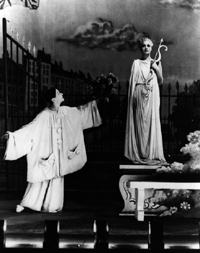

France film school
1945
bw 195 min.
Director: Marcel Carne
CLV: $89.95 - available
2 discs, catalog # CC1249L
VHS: available from Home Vision Cinema

Children of
Paradise is the high-water mark of the Golden Age of French cinema. This is
the movie that is routinely ranked number one of all time, in surveys of French
film critics of French movies. More than once it has been called the "Gone
with the Wind of French films", for the fondness in which it is held.
Children of Paradise is always playing in a Paris moviehouse, just as
Gone with the Wind is in permanent residence in Atlanta.Unlike the
Civil War epic, it is not set in a wartime -- Part One, according to the script,
is set in "1827 or 1828" in Paris, and Part Two a few years later -- but
Children of Paradise was filmed during a war, strongly marking its
production. Written under the German occupation of France, and produced with the
sanction of occupation censors, the film began shooting on August 17,1943, at the
Victorine Studios in Nice. Rumors of a possible Allied landing in nearby Italy
prompted authorities to shut down the production and send cast and crew back to
Paris, where other scenes could be shot. Production resumed in Nice in February
of 1944 and concluded shortly before the Allied landing at Normandy in June of
that year.
The huge production staff was practically a model of the French
nation at this troubled time. One crew member, secretly active in the Resistance,
was eventually caught and arrested on the set by the Gestapo. Another, a featured
member of the cast (playing, in fact, a police spy) was known to be a
collaborator, and had to flee for his life early in the production; his scenes
had to be reshot with a new actor.
These and other physical hardships
surrounding the shooting of the film in a time of severe rationing are completely
hidden in this most lavish production. Yet the tenuous political atmosphere
surrounding its creation gives Children of Paradise its unique flavor --
and invites readings of political subtexts that may or may not be there.
In the
opening scene, for instance, a pretty woman (who works in the carnival as the
naked subject of "Truth in her Bath") is arrested in the crowd, under the false
suspicion of having pickpocketed someone. This is not the last time in the film
that Garance (played by Arletty) will be "the victim of a judicial error." On the
stage before them, the humbled, abused little mime Baptiste Deburau, played by
Jean-Louis Barrault, for whom the part was written -- tells, in pantomime, the
true story of the pickpocketing, and so liberates Garance.
It is tempting to
see in this an allegory of how art can liberate the spirit of a people under
occupation. But director Marcel Carne; and writer-poet Jacques Prévert so
skillfully covered their tracks that you can never be sure. The film must
"conceal" the truth -- that Frenchmen are being arrested and deported and killed
by an alien occupying force -- yet its message of hope may appear in disguise. So
we get a movie that moves between nakedness and disguise, between falsehood and
truth and back again, as it gives us a behind-the-scenes view of the members of a
theatrical company in 19th-century Paris, and what becomes of them later.
This
is, after all, a backstage film, a movie that tells us, in the style of poetic
realism, how theater people live -- and how the stage mirrors and transmutes what
they experience in life. Marcel Carne, as he tells us in an exclusive interview
on this disc, explicitly conceived the film as "cinema's homage to the theater."
Children of Paradise: The name refers, at least initially, to the "kids"
who sit in the cheapest (and highest) seats at the local vaudeville house. But
the title expands to cover the actors whose offstage lives we enter, and
eventually includes us as their audience.
Above all, this is a love story: how
four different men loved the same woman in four different ways. And it's an
adventure story full of transformations, duels, and yes, even murder. Three of
the main characters are historical. Baptiste Deburau (1796-1846) and Frederick
Lematre (1800-1876; played by Pierre Brasseur) were two of the most famous stage
performers of their day. Pierre-Francois Lacenaire (1800-1836; played by Marcel
Herrand) was a famous criminal and dandy, on whom Dostoevsky based the character
of Raskolnikov in Crime and Punishment. Carne and Prévert used documents
from the period, including engravings of Paris' colorful boulevard life at the
time, in part to inspire designer Alexandre Trauner's breathtakingly deep sets,
and also to give historical ballast to their own multi-decked story.
This is
classic cinema: a moment in time and in the history of the imagination, captured
with extraordinary visual richness and bravura performances. The film's comedy
and density alike have provoked extensive discussion, as noted in the supplement.
On Analog Track 1, an audio essay annotates and comments upon the film. Marcel
Carne made himself available for an exclusive two-hour conversation, recorded in
the original French on Analog Track 2, and excerpted in an English translation on
Analog Track 1 of side 3. Production stills, the script treatment, and a gallery
of painterly images from the film accompanied by their sources from the Louvre,
complete this laserdisc edition of a high point of the celluloid art.
--
BRIAN STONEHILL
Credits
Director: Marcel Carné
Screenplay:
Jacques Prévert
Assistant Directors: Pierre Blondy, Bruno
Tireux
Director of Photography: Roger Hubert
Editors: Henri Rust, Madeleine
Bonin
Music Directors: Maurice Thiriet, Joseph Kosma
Set Decoration:
Alexandre Trauner, Georges Wakhvitch
Producer: Raymond Borderie
Production
Company: S.N. Path Cinema
Original Title: Les Enfants du
Paradis
Transfer
This edition of Children of Paradise
was transferred digitally from a restored negative, with newly translated and
designed English subtitles.





